There are 33 UNESCO Heritage Sites in the UK and 7 UNESCO Biosphere Sites. Let’s take a round-up view of some of the more unusual UNESCO heritage and biosphere sites around The UK and UNESCO sites in the UK that deserve a visit.
The sixth in my series about UNESCO sites off the beaten track takes us home to the UK. My fellow bloggers have helped me produce the following list of unusual UNESCO Heritage sites in The UK.
*This site uses affiliate links and I may earn a small commission when you use my links and make a purchase without incurring an additional fee yourself.
Thank you for supporting this website. See my disclaimer page for more details.
UNESCO Heritage sites in The UK
Avebury Henge, Wiltshire
by Faith from XYU and Beyond

Everyone knows the UNESCO site of Stonehenge very few have heard of the Avebury Henge. Some believe that Avebury far surpasses Stonehenge as the largest and most complex henge in England. The village of Avebury sits right at the heart of this massive henge and it is a lovely place to wander with several interesting places to visit.
There are 100 local stones in the henge weighing up to 20 tons and stand up to 6 metres high. Many of the stones were pulled down in the 14th century and others were used for building the village in the 18th century.
Alexander Keiller who bought the site and spent years maintaining it and studying Avebury was heir to a Scottish marmalade business and he used his fortune to preserve Avebury.
The National Trust Avebury now manages the henge and you can park for £7 per day, and wander the henge and the village to your heart’s content. There is a short cut path from the car park to the village and the loop around the stones.
Wear some good hiking shoes or boots and avoid the sheep poop on your walk around this incredible site. In the village itself, you should check out the Henge Shop which is full of fascinating ephemera, crystals, and pagan icons.
Avebury Village has a beautiful church that dates back to the Saxon era. Avebury Manor is a Tudor manor house of monastic origin. You can take a tour to a part of the house and gardens most afternoons and you can actually touch the items and experience the Manor as if you lived there.
Near the manor, you will find the Alexander Keiller Museum full of his finds from his work at the henge. A stunning dovecote and a great visitors centre with a cafe and lots of activities for children are near the museum.
From the famous Red Lion pub, you can watch the folks wandering through the stones and on occasion, there will be a pagan/new age solstice rituals taking place in the henge.
Maritime Greenwich
by Teresa from Brogan Abroad
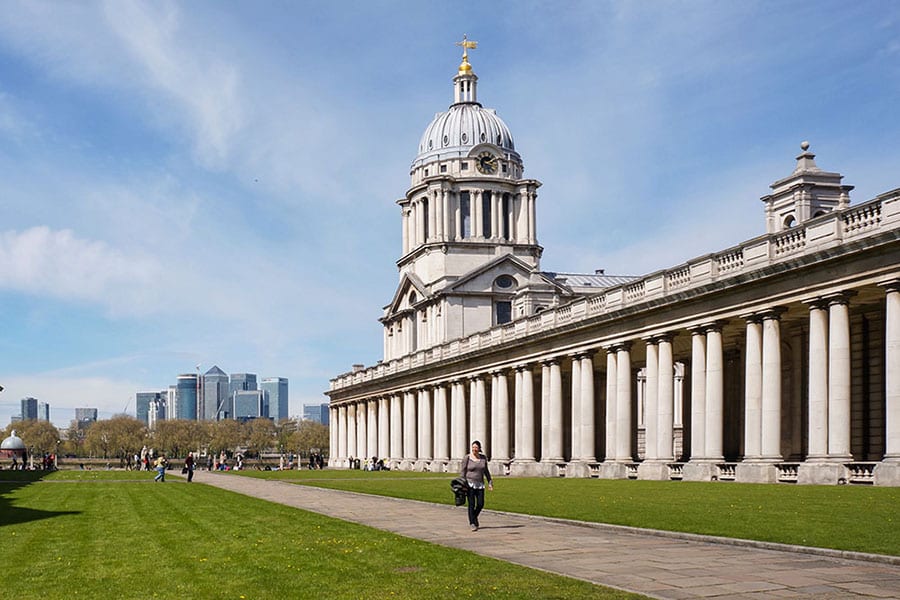
Nestled along the banks of the Thames in South East London, Greenwich is an area with over 500 years of history where many royal members of the House of Tudor were born. Today is better known for its maritime history, which has earned it the title of UNESCO World Heritage Site. Often overlooked by visitors to the city, Greenwich makes a great day out away from the crowds in Central London.
It was here that the Old Royal Naval College was built and designed by Sir Christopher Wren, the architect of St Paul’s Cathedral. The Naval College was built in the 17th century to house retired men who had served in the Royal Navy, it later became the best naval college in Europe and today it’s open to the public for all of us to enjoy.
One of the highlights of the College is the Painted Hall, also known as Britain’s Sistine Chapel. This Baroque masterpiece will have you marvel at the painted walls and ceiling, and the secrets that these paintings hide.
Other maritime-related things that you can do while in Greenwich, include visiting the National Maritime Museum, and the Cutty Sark, the world’s only surviving tea clipper and an award-winning visitor attraction.
But there is a lot more to Greenwich than its naval history. Here you can also visit the Queen’s House, with the perfect spiral of the Tulip Staircase, and the famous Greenwich Observatory, where the Greenwich Meridian (longitude 0º) was named and where Greenwich Mean Time was founded.
YOU MIGHT ALSO LIKE: UNESCO Heritage Sites Off The Beaten Track – Europe
Durham Cathedral, County Durham
by Sinead from Map Made Memories

The 11th Century Durham Cathedral is one of the lesser-known UNESCO heritage sites in the United Kingdom. The imposing cathedral dominates the skyline of the historic northern city of Durham.
Durham is an easy city to reach by rail as it is approximately halfway on a train trip from London to Edinburgh. Plus, the city is small and easily covered on foot. The city’s famous cathedral has gained recent fame and popularity after its’ scenic, arched cloisters were used as a setting for Hogwarts School in the Harry Potter movies.
The ornate cathedral is an intriguing mix of architectural styles with modern and Victorian stained glass windows and a Gothic 13th Century Chapel of Nine Altars. In addition, enormous Norman era carved pillars with rounded Romanesque arches line the stone-flagged nave.
Though the current edifice dates from the 11th Century, there has been a cathedral on this site since 995 AD. The site has long been a place of pilgrimage as the cathedral holds the relics of Saint Cuthbert and Saint Oswald. Entry to this UNESCO site is free but a donation of £3 per person is suggested in order to maintain the cathedral and to keep entry costs low.
Jurassic Coast, Dorset and East Devon
by Emily from Kids and Compass
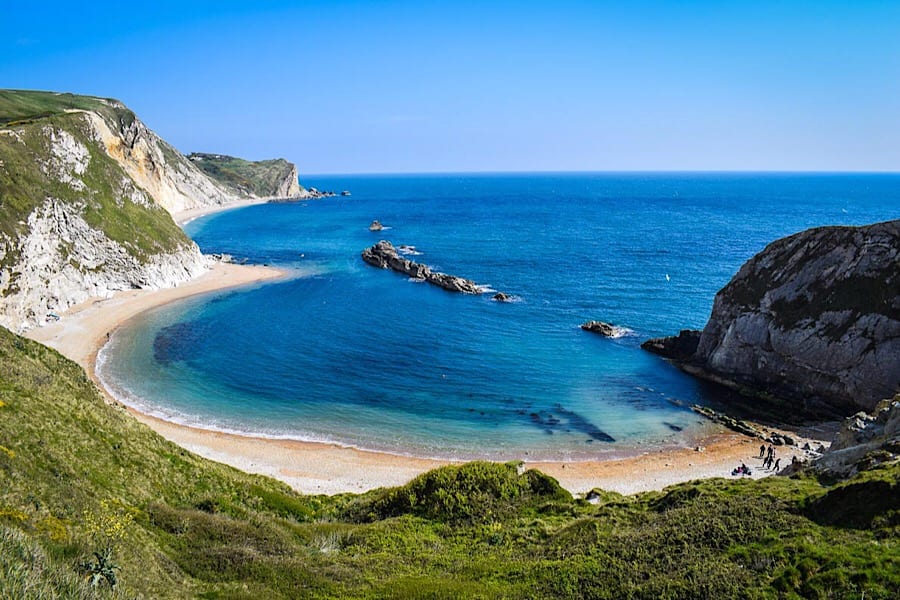
The Jurassic Coast is the UK’s first natural World Heritage Site, and one of the most picturesque areas of England. The Jurassic coast stretches for 95 miles along the south-west of England, crossing the counties of Dorset and East Devon.
Anyone with a passing interest in geology will love exploring this coastline. It’s where Mary Anning found many of her famous fossils, and you can follow in her footsteps by searching for your own. There are fossil tours you can take or you can try your luck by yourself.
Some of the best areas of the Jurassic Coast are found at West Bay, with its plunging cliffs (made famous in the TV show Broadchurch); the equally famous Chesil Beach, and pretty seaside towns like Lyme Regis, Abbotsbury and Sidmouth are great places to enjoy the British tradition of fish and chips.
Don’t miss out on the area around Durdle Door either. There’s a great walk between Lulworth Cove and Durdle Door which allows you to see some really amazing cliff formations and beautiful turquoise bays. You can picnic on the pebble beach at Durdle Door before you walk back. There are plenty more walking trails along the coastline which will keep hikers busy for days!
The best way to reach the Jurassic Coast is by car. However, if you don’t drive you can take trains from London Waterloo to Dorchester, Wareham and Poole in Dorset or Exeter in Devon. Once you’re there you can get along the Jurassic Coast by using the Jurassic Coaster bus services (more information here).
Pontcysyllte Aqueduct
by Elizabeth from The Fearless Foreigner
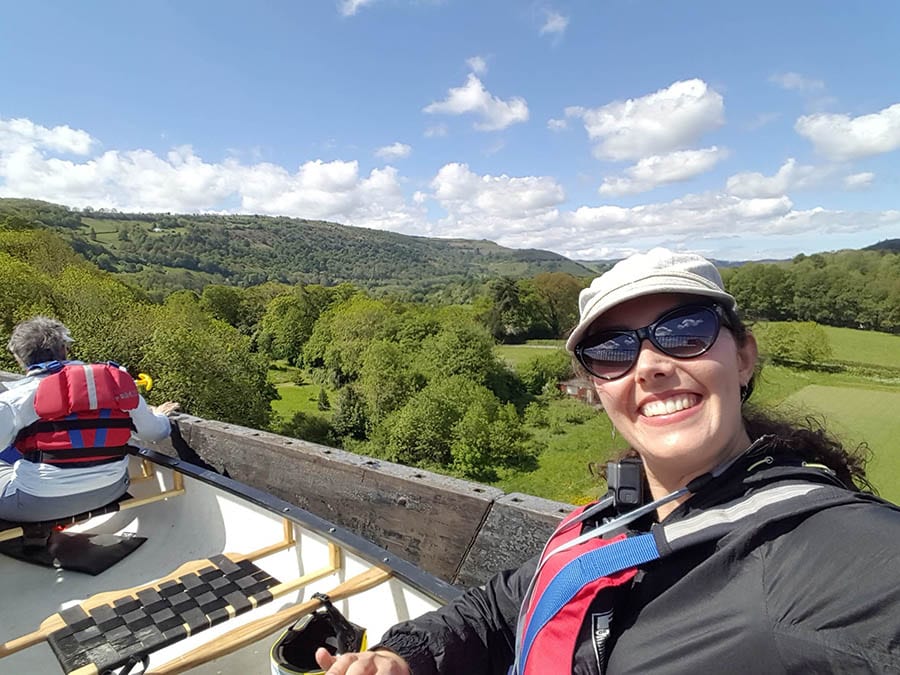
Known as the “stream in the sky”, the Pontcysyllte Aqueduct along with the Llangollen Canal is a UNESCO World Heritage site. Located in northeastern Wales the Pontcysyllte Aqueduct and Canal stretch 18km. While the majority of the canal isn’t in the air, the Pontcysyllte Aqueduct is 125 feet above the River Dee! It is the highest aqueduct canal in the world! When it was built in 1805 as an industrial waterway it was considered an amazing accomplishment in civil engineering.
It continues to impress visitors today. The canal and aqueduct are still navigable today as they were a couple of hundred years ago. The only difference is that they are only used for recreation now. There is a path that runs along the entire length of the canal.
You can also rent a boat or take a guided boat trip along the canal. If you are looking for a unique way to explore the area, paddle your own way! Take a guided canoe trip and get very close to the edge of the aqueduct. Don’t look down as you go across if you are afraid of heights!
There is no cost to see the aqueduct or to walk alongside the canal. The rates for boat and canoe trips vary. To take a boat trip or canoe trip you will start at the Pontcysyllte Aqueduct car park. You can begin walking along the canal from this end or from the town of Llangollen. Ideally, you should explore the canal by land and by foot.
YOU MIGHT ALSO LIKE: UNESCO Heritage Sites Off The Beaten Track – Middle East
Kew Gardens
by from Travel Past 50

The Royal Botanic Gardens at Kew, or Kew Gardens as they are familiarly known, are difficult to sum up. First, there is a huge garden in the English landscape garden tradition. Elements of the historic landscape garden illustrate significant characteristics of the art of gardens from the 18th to the 20th centuries. What that means, practically, is there are miles of enjoyable walkways among thick plantings of flowers, trees, and green bushes.
Second, Kew Gardens is a huge botanical reserve. The gardens house collections of conserved and living plants, and documentary records plants, that have been enriched through the centuries. Since Kew Gardens’ creation in 1759, they have made a contribution to the study of plant diversity and economic botany.
The focus of the botanic activity is centred on two large iron-framed glasshouses – the Palm House and the Temperate House, that became models for conservatories around the world. These buildings and collections became exemplary developments in garden art and botanical science that were subsequently diffused around the world.
Other significant features of Kew Gardens include the Orangery, Queen Charlotte’s Cottage, several ornamental lakes and ponds, and a boundary “ha-ha.” There is also a lovely long vista to a multistory pagoda situated near the west end of the gardens.
Canterbury
by Mansoureh from Travel with Mansoureh

Canterbury, a small beautiful city in Kent, might be more famous for the Canterbury tale nowadays, but it was a pilgrimage site in the Middle Ages. This English city with its rich history and culture is home to one of the oldest Christian structures and one of the UNESCO World Heritage Sites in England.
Canterbury Cathedral, with its Romanesque and Gothic architecture, hosted the spiritual head of the Church of England for almost 500 years. Here is where Archbishop Thomas Becket was murdered in 1170.
Canterbury Cathedral together with St Martin’s Church, the oldest church in England, and the ruins of St Augustine’s Abbey all played a major role in the history of Christianity in Britain, and they are listed on the UNESCO World Heritage Sites.
You can go for a day trip to Canterbury from London to visit all three of these monuments. The Cathedral is open every day from 9 am – 5 pm except for Sundays when closes half an hour earlier.
The entrance fee for adults is £12.50, but there is no entrance fee for visiting St Martin’s Church on Tuesdays, Thursdays, and Fridays from 11 am to 3 pm. Keep in mind that you can only visit St Augustine’s Abbey during the weekends (only Saturday and Sunday) from 10 am to 4 pm.
King Edward the 1st Castles, North Wales

by Bec from Wyld Family Travel
Although Edward the 1st built or renovated many castles in Wales there are only 4 that make up the UNESCO World Heritage Site Beaumaris Castle, Harlech Castle, Conwy Castle and Caernarfon Castle. All four are mainly now all ruined castles but it does not take away their magnificence or their dominance of the landscape where they were built. They are hundreds of years old and yet they are still as intimidating and imposing on the Welsh landscape as if they were brand new.
The 4 beautiful castles that were included in the UNESCO fold were added to the list as the “finest examples of late 13th century and early 14th-century military architecture in Europe” it is unknown why the rest of the castles he built in the area were not included. There are many dotted around the countryside including the most well known Rhuddlan Castle and Flint Castle.
They are all very different castles but they are all similar in the fact that they were built to impress and terrify those wanting to invade from home and abroad. Their positions at headlands or high on a peak overlooking what must have seemed like the entire earth made them formidable to anyone.
Caernarfon is probably the most well known as it is where the title of ‘Prince of Wales’ came from.
There is so much you can learn from the castles with rooms painstakingly repaired to make sure that the history of these buildings is not completely lost. For the ones that have not been able to dedicate rooms to information, there is some outside. You will find this at all of the castles that Edward built not only the 4 in the UNESCO bundle.
YOU MIGHT ALSO LIKE: UNESCO Heritage Sites Off The Beaten Track – Asia
Fountains Abbey, Yorkshire, UK
by Anisa from Two Travelling Texans

Fountains Abbey and Studley Royal Gardens is a UNESCO site in the Yorkshire England countryside near the city of Ripon. While there are many abbey ruins across the United Kingdom, this one is the only one to be named a UNESCO site. The fact that the Abbey ruins have been incorporated with the Studley Gardens make it unique.
The Abbey was founded in 1132 and operated for 407 years! It was one of the wealthiest monasteries in England until Henry VIII ordered its dissolution in 1539. In 1761, the owners of Studley Gardens next door purchased Fountains Abbey making the two sites one.
There is so much to see at Fountains Abbey, I am not sure if it’s possible to see it all in one visit. Of course, you must explore the huge Fountains Abbey ruins but there is also the Fountains Mill, Fountains Hall, Studley Royal Gardens, Studley Deer Park, and St. Mary’s Church. The grounds were much bigger than I expected.
Tickets to visit Fountains Abbey and Studley Royal cost £16 for adults and £8 for children. There is also a family ticket for £40. National Trust and English Heritage members can visit for free. The Studley Deer Park and St. Mary’s Church are free for all to visit.
The Lake District
by Laura from Anywhere She Roams

Where it is
Visiting the Lake District gives you the perfect glimpse of Northern England and the beauty of the countryside, which are a complete contrast to the industrialized cities.
The Lake District is 1-2 hours away from Manchester, or about 4-5 hours from London which makes it very accessible if you arrive into the United Kingdom by plane.
There are plenty of public transport options to get there or it is possible to get a hire car.
What makes it special
England’s largest UNESCO National Park is a gem of a place to visit. With breathtaking lakes, soaring mountains, picturesque valleys, and even sandy coastlines no matter what time of year you visit it is always beautiful.
Each lake and valley has a distinct character of its own and because of this, the lakes have inspired many artists, poets, and writers over the years, including Willam Wordsworth and John Ruskin. Broken up into several areas; Windermere and Ambleside, Coniston, Keswick and Derwentwater, Grasmere and Rydal, Ullswater and Glenridding, and the Langdale valleys there is so much to explore. If you love the outdoors you will not be stuck for things to do.
Any fees for getting in to see it
The best way to get around the lakes would be by car, as it is quite spread out. There are not as many public transport options as you would find in the cities so be prepared for this. Whilst the majority of the Lake District is free to explore, there can be a few charges which will add to the expense of your trip, such as car-parking and visiting the Heritage buildings, however, most of this funding goes towards the preservation of the area through the National Trust.
Saltaire, Yorkshire
by Anna from My Travel Scrapbook

Saltaire is one of the UK’s most underrated UNESCO sites! Many Brits have never even heard of Saltaire, let alone added it to their UK UNESCO site bucket list. Saltaire is heaven for art lovers, industrial heritage seekers and Victorian history.
Located in West Yorkshire, Saltaire was built in 1851 by a Victorian philanthropist known as Sir Titus. He built a giant mill and model village with houses, shops, a church, community centre and school for his mill workers on the banks of the River Aire. Given its proximity to the river, he decided to combine his name with the name of the river to call this place Saltaire.
Back in the 19th century, life expectancy in the inner cities was very low given the dangerous pollution levels. Therefore, Titus was determined to build his model village on the Yorkshire Hills by the river yet close enough to the Leeds-Liverpool canal to transport the goods produced at the mill.
Sir Titus’ legacy has left an intriguing village behind with plenty of things for visitors to see. There are many free things to see and do in Saltaire such as the giant Salt Mill itself, the quirky independent shops or the picturesque park.
You can also go on a canal trip, enjoy a vegan meal or even treat yourself to an alcoholic beverage. Sir Titus famously built no pubs in his model village as he felt that alcohol was dangerous for his workers. Nowadays there is a bar, rather humorously named “Don’t tell Titus”.
Whatever you decide to do in Saltaire, you will enjoy visiting this wonderful UK UNESCO World Heritage site.
YOU MIGHT ALSO LIKE: UNESCO Heritage Sites Off The Beaten Track – The Americas & The Caribbean
The Neolithic Heart of Orkney, Scotland
by Suzanne from Meadering Wild

The Neolithic Heart of Orkney is a UNESCO site that covers the whole of one island. Situated 8 miles north of Scotland is a small collection of islands called Orkney. The main island (known as Mainland) has a number of sites that are collected together as one UNESCO listing.
Built over 4000 years ago when Orkney was an important location in the Neolithic world these sites are unique and full of history. Older than Stonehenge and the Pyramids but far less well known this area is stunning.
Skara Brae is a Neolithic village that was discovered just over 100 years ago when a storm washed away sand dunes on a beach. What was found was an intact village including beds, hearths and dressers. This would have been a thriving village but no-one knows why it was lost.
Just a short distance away are two lochs separated by a strip of land. The largest archaeological dig in Europe is currently taking place and each year it is uncovered and more discoveries are made at the Ness of Brodgar.
Nearby and very definitely linked to the archaeological dig is the Ring of Brodgar. This is a complete stone circle. Also nearby are the Stones of Stenness and the large burial mound known as Maes Howe.
Getting to Orkney is not easy. It is a six hour drive and ferry crossing from Edinburgh or Glasgow. You can also fly to the islands from the main Scottish Airports but once on the islands you will need to book a tour or hire a car to get to the sites.
The Stones of Stenness and Ring of Brodgar are free to visit and open at any time. However, Maes Howe can only be visited by booking a tour at the visitors centre. Skara Brae has a beautiful visitors centre and café which has an admission fee but is worthwhile.
The Giant’s Causeway and Causeway Coast
by Allan from It’s Sometimes Sunny in Bangor
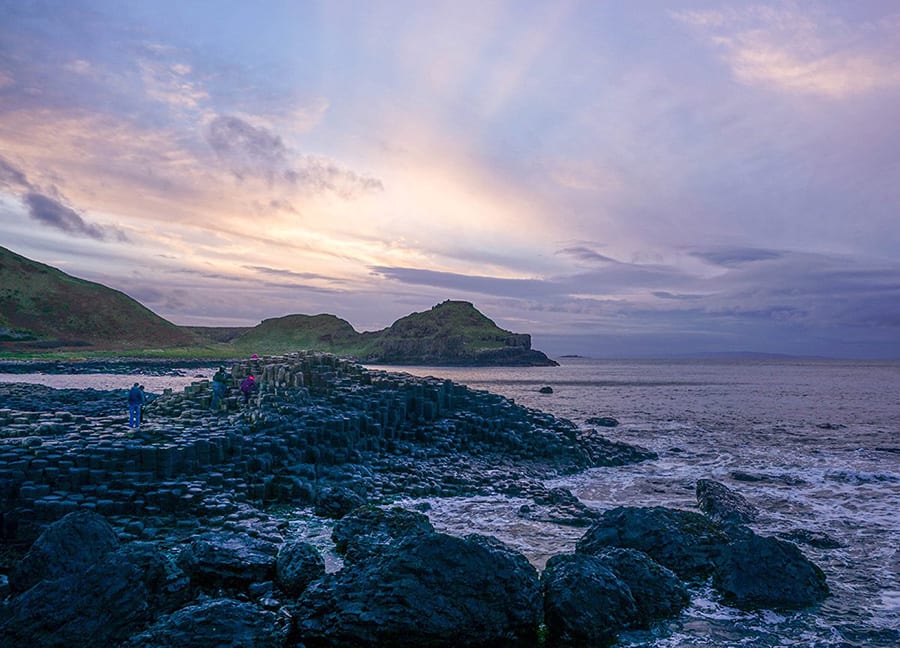
By far the most famous landmark as well as UNESCO world heritage site in Northern Ireland is the Giant’s Causeway, a coastline of towering interlocking basalt columns (40,000+) that line the rugged coasts of County Antrim.
It is also an attraction that can be visited for free, given it is public land, but many tourists are often duped into paying around £11.50 per person to use the car park and visitor centre of the National Trust, whereas, it can otherwise be tricky to find parking nearby (our guide to free entry to the Giant’s Causeway here).
Anyway, while it is the main tourist attraction of the region, the UNESCO World Heritage Site status has now been extended to now include around 29km of coastline which is also a designated Area of Outstanding Natural Beauty (AONB) known as ‘The Giant’s Causeway and Causeway Coast’.
And there really are many reasons to explore the coastline, which includes around a dozen or more ‘Game of Thrones’ filming locations, where the more popular attractions include the Carrick-a-Rede Ropebridge, the cosy harbour of Port Ballintoy (“Iron Isles’ from the Game of Thrones), the cliff ruins of ‘Dunluce Castle’, and, a personal favourite, Bushmills whiskey distillery.
And while I will always encourage a weekend road trip to fully make the most of the Causeway Coast, the more prominent sites can still be covered on the daily coach tours leaving the central travel hubs of Belfast.
YOU MIGHT ALSO LIKE: UNESCO Heritage Sites Off The Beaten Track – Africa
Stonehenge
by Viktoria from Chronic Wanderlust

The mystical site Stonehenge is definitely worth your time when visiting the UK and hunting down the impressive UNESCO sites around the country. It is situated north of the city Salisbury (which you should check out as well) in Wiltshire in England.
While there are other places with standing stones and monoliths, Stonehenge is by far the most known one. The ring of standing stones has fascinated visitors, historians and researchers alike as the true meaning and function of the site is still unclear.
Today Stonehenge is considered a British cultural icon and many flock there to visit the stones. But what makes it so special and is it really worth paying a hefty fee to enter the grounds?
Since the purpose of Stonehenge is unclear there are many legends and interpretations, some of which you can read about in the excellent museum when you arrive. Make sure to be there early in the morning to avoid the masses. Or sign up for a special night tour that is only organized on rare occasions.
Visiting Stonehenge is not a cheap undertaking since the tickets are currently £19 (December 2019). I highly recommend booking them online to save time when arriving. Please note that you won’t be able to enter the stone circle, only the path to the sides.
If you are not up to spending that kind of money, you can also drive past on A303 and catch a glimpse of the standing stones. There are no parking spots there, so you might want to drive past a few times.
The City of Bath
by Laura from What’s Hot

The city of Bath was made a UNESCO world heritage site in 1987 but it’s a wonder it wasn’t made one sooner with its infamous Roman Baths which date back millennia. Bath is unique in that it is one of only a handful of city-wide UNESCO world heritage sites and this means that the entire city is protected. It is one of England’s most culturally rich towns with Roman ruins, beautiful bridges, 18th-century architecture, Jane Austen’s former residences and more.
The Roman Baths are the top site to visit and are the remains of the Roman temple of the Goddess Minerva. Bathing was a popular activity in Roman times and you can learn all about the history of this practice as you walk around. It’s rather pricey at £18 per adult ticket on weekends but if you book online you can save 10%.
Whilst these baths have not been used in thousands of years, you can experience a modern-day hot spring in Bath too. Bath’s hot springs are the only ones in Britain so it’s not something to miss. Although the main pool at Thermae Bath Spa is outdoors, the hot waters will keep you warm and you’ll be treated to stunning views of Bath.
One of the greatest things to do in Bath is to simply wander the streets and admire the 18th-century architecture. These buildings look like something straight out of a novel and much of Bath is in fact featured in Jane Austen’s books as she lived and wrote there. After a day of history, it’s well worth going on a literary tour of Bath including the many Bath bookshops.
UNESCO Biosphere Sites
Brighton and Lewes Downs Biosphere
by Danielle from Live in 10 Countries
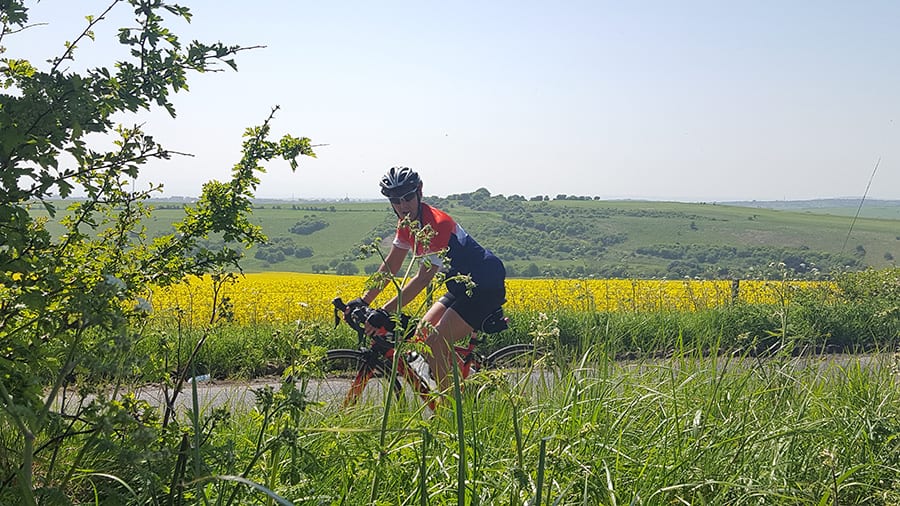
If you fancy great walks and bike rides by the South Coast, head straight to this lovely spot in Sussex. The Brighton and Lewes Downs Biosphere covers a glorious section of the South Downs National Park, one of very few such UNESCO spheres in an urban area.
It’s pure, beautiful countryside and free and open to the public at any time of day and night. Even better, it’s easy to get up there without a car as buses run from the local city of Brighton with its eclectic vibes, or towns along the coast like Worthing. There is an excellent park, however, if you do decide to drive – and ideally, car share to keep things green.
Once there, you’ll see it’s a very special place. There’s luscious green in every direction spread across the chalk downland. You won’t want to miss Beachy Head with its marine conservation area, a stunning chalk valley at Devil’s Dyke (which is great for picnicking) and cliffs that still bear witness to the Ice Age.
For history fans, it even has evidence of a Neolithic camp at Whitehawk, a gem that shows some of the earliest signs of human activity.
This is definitely one day out that you won’t want to miss in the South East!
The Isle of Man
by Larch from The Silver Nomad
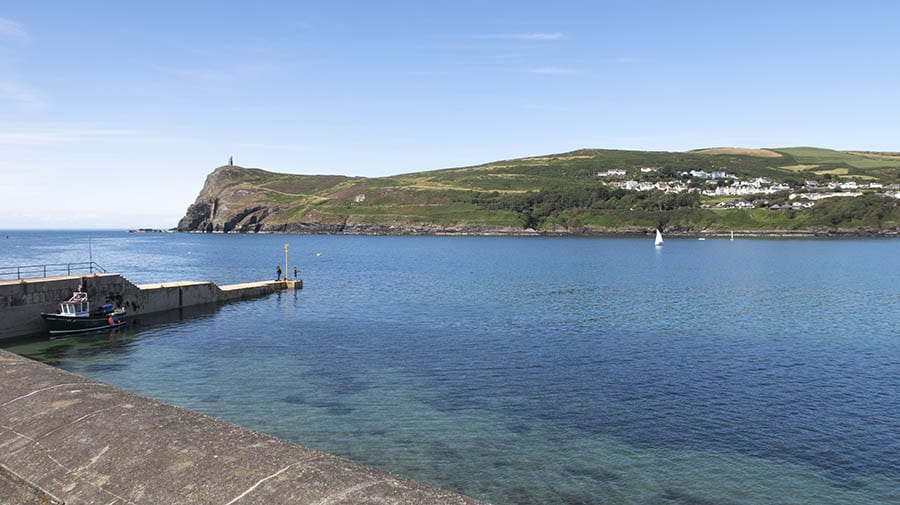
The Isle of Man is not actually a Heritage site, but the whole island has been awarded the status of UNESCO World Biosphere Region. It is the first entire island nation in the world to achieve this title.
The Biosphere status covers not only the flora and fauna on the Isle of Man but the culture, heritage and way of life on the island, a balance between nature and the people.
Sitting in the Irish Sea, the Isle of Man is only 33 miles long and 13 miles wide with sweeping uplands covered in gorse and heather, both sand and pebble beaches, soaring cliffs and over 100 miles of coastline.
The Calf of Man off the southern tip is a Nature Reserve and Bird Sanctuary with regular visitors of over 30 different species. It is also a breeding ground for seals who hang out on the rocks.
With are castles to explore, Norse history to investigate, the thousand-year-old Tynwald Parliament, the famous TT motorbike racing to watch and at night, when there are clear skies, stargazing in one of the 26 official dark sky sites on the island, there is plenty to do on the island.
Wherever you are on the Isle of Man, you are not more than a few miles from the glorious coastline, a place to visit or a restaurant selling ‘queenies’, the island’s succulent scallops.
Don’t forget to pin this article so you can come back to it later



The 33 UNESCO Heritage Sites in the United Kingdom
- Blaenavon Industrial Landscape (2000)
- Blenheim Palace (1987)
- Canterbury Cathedral, St Augustine’s Abbey, and St Martin’s Church (1988)
- Castles and Town Walls of King Edward in Gwynedd (1986)
- City of Bath (1987)
- Cornwall and West Devon Mining Landscape (2006)
- Derwent Valley Mills (2001)
- Durham Castle and Cathedral (1986)
- Frontiers of the Roman Empire (1987, 2005, 2008)
- Gorham’s Cave Complex (2016)*
- Heart of Neolithic Orkney (1999)
- Historic Town of St George and Related Fortifications, Bermuda (2000)*
- Ironbridge Gorge (1986)
- Jodrell Bank Observatory (2019)
- Maritime Greenwich (1997)
- New Lanark (2001)
- Old and New Towns of Edinburgh (1995)
- Palace of Westminster and Westminster Abbey including Saint Margaret’s Church (1987)
- Pontcysyllte Aqueduct and Canal (2009)
- Royal Botanic Gardens Kew (2003)
- Saltaire (2001)
- Stonehenge, Avebury and Associated Sites (1986)
- Studley Royal Park including the Ruins of Fountains Abbey (1986)
- The English Lake District (2017)
- The Forth Bridge (2015)
- The Great Spa Towns of Europe (2021)
- The Slate Landscape of Northwest Wales (2021)
- Tower of London (1988)
Natural UNESCO Sites (4)
- Dorset and East Devon Coast (2001)
- Giant’s Causeway and Causeway Coast (1986)
- Gough and Inaccessible Islands (1995, 2004)*
- Henderson Island (1988)*
Mixed UNESCO Site (1)
- St Kilda (1986, 2004, 2005)
7 UNESCO Biosphere Sites
- Biosffer Dyfi
- Brighton and Lewes Downs
- Galloway and Southern Ayrshire
- Isle of Man
- Isle of Wight
- North Devon
- Wester Ross

I loved reading through the list of UNESCO heritage sites in the UK. I was thrilled that I have visited a few of them from this list and made a note of the others for my future visits. Thanks for the interesting read!
I have noted a few down too, Jan. We have some amazing places to visit in the UK.
What an impressive collection of places to visit! To be honest, Saltaire really caught my attention as I’ve never heard of it. It made me curious to know morexabout the place and its curious history. Thanks for the great read.
Glad you enjoyed it Gabi. Sometimes there are places on our own doorsteps we have never heard of!